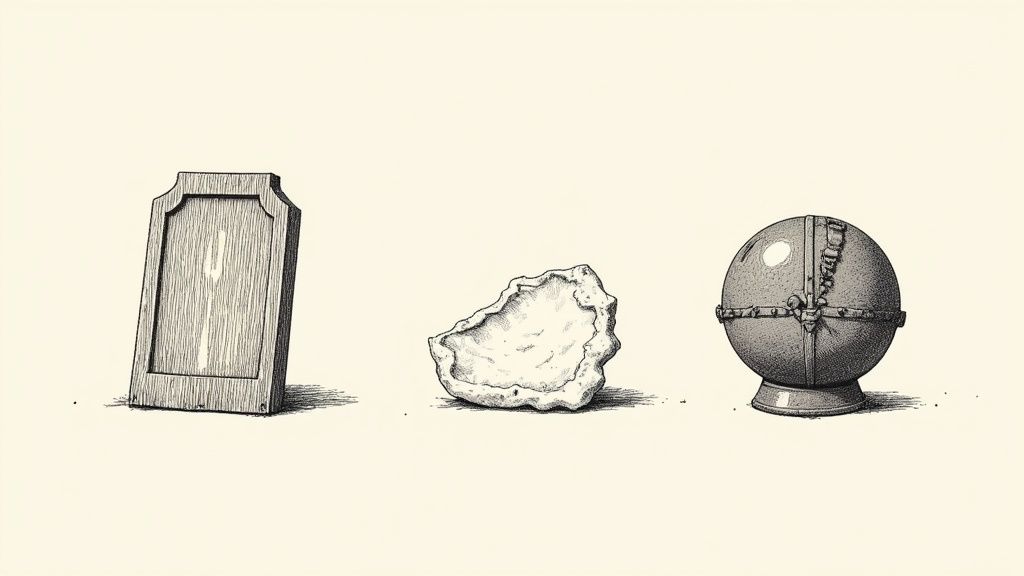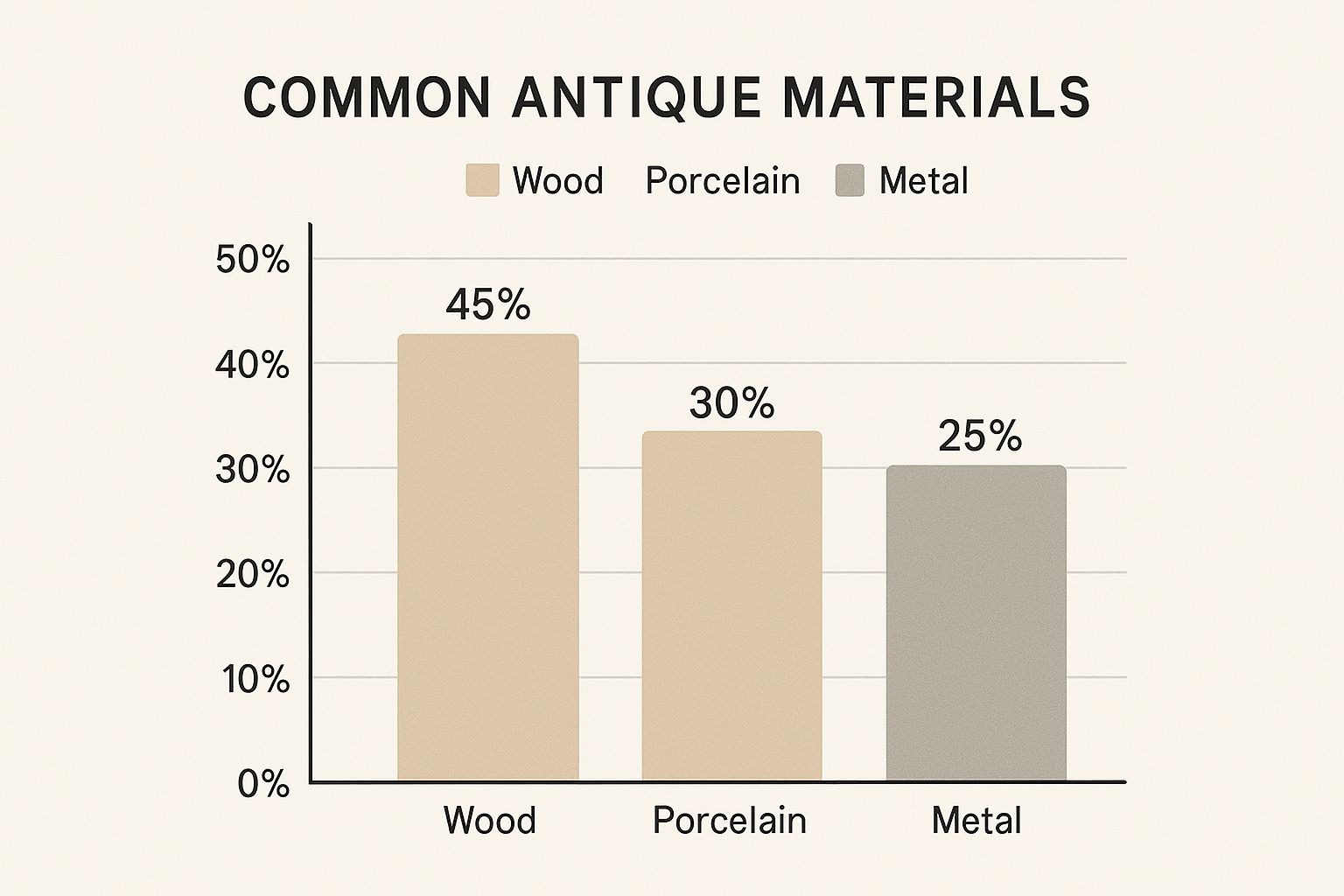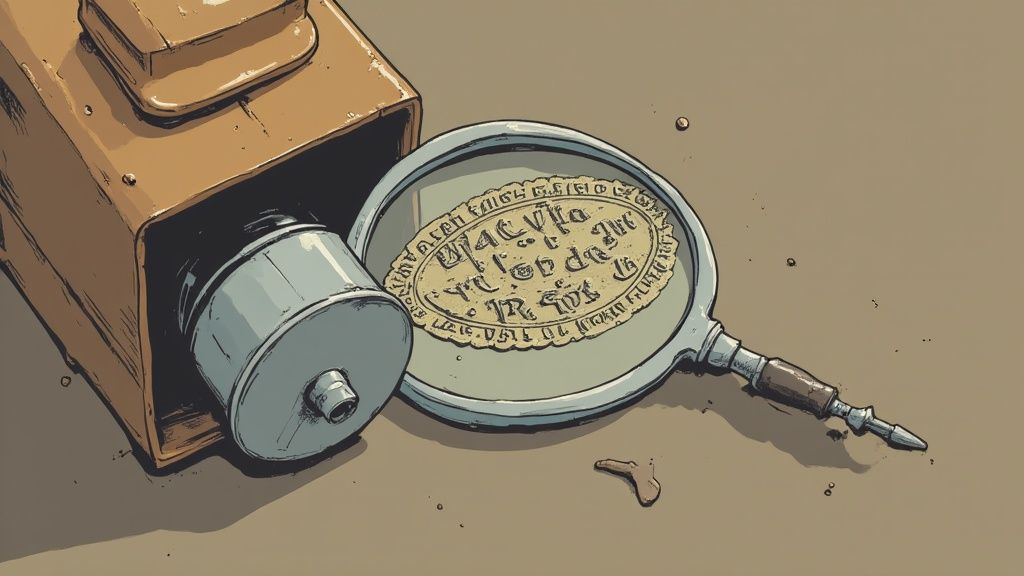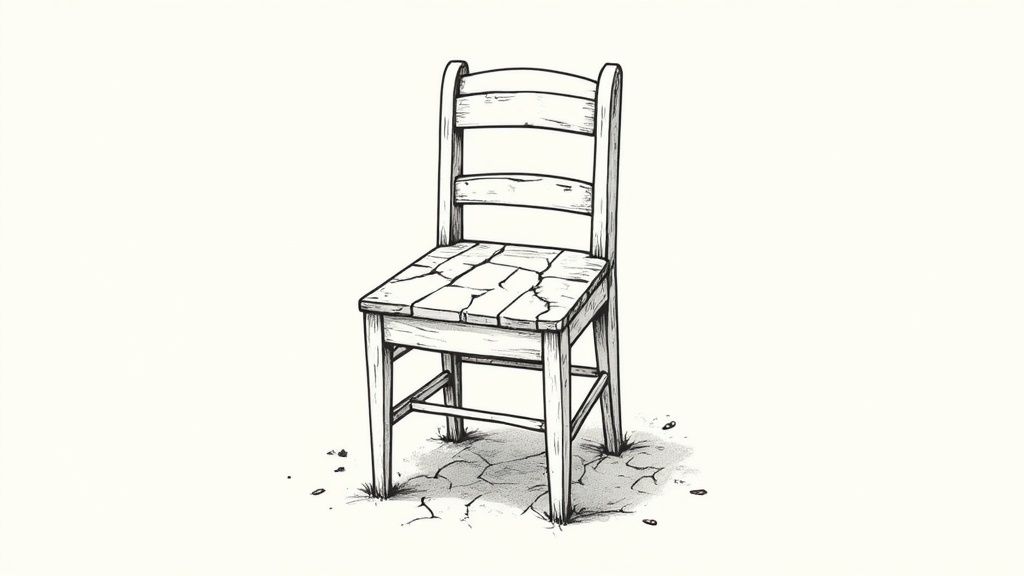How to Identify Antiques: Expert Tips to Recognize True Value
Reading the Stories Hidden in Plain Sight
Walk into any antique shop with a seasoned collector, and you'll notice something interesting: they seem to see more than the average person. While you might admire the pretty exterior, they’re examining the scratches, worn edges, and faded finishes – all the clues that tell the story of the piece. Authentic antiques carry their history in a way reproductions simply can’t. It's the difference between a well-loved leather jacket and a brand-new one artificially distressed. One has genuine character; the other, a manufactured illusion.
This “X-ray vision” comes down to understanding wear patterns. Imagine a chair from the 1800s. The arms will show wear where hands have rested for generations. The legs might be slightly uneven from decades on uneven floors. The seat will probably have a subtle indentation. These are the marks of time, of actual use. They’re incredibly hard to fake convincingly. I remember finding a supposedly antique porcelain doll at a flea market. It looked the part, but the wear on the painted features was too uniform, too perfect. That’s how I knew it was a modern reproduction.
Spotting the Difference Between Natural Aging and Artificial Distressing
Manufacturers try to replicate these signs of aging. They sand down edges, apply artificial patinas, and even add deliberate "damage." But these manufactured imperfections often lack the subtle nuances of genuine wear. Artificial distressing tends to be uniform and predictable, while real wear is organic and irregular. Think of a genuinely old wooden table. It’ll have a softer, more varied patina than a reproduction quickly stained and sanded to mimic age.
This is where actually handling a piece becomes important. Run your fingers over the surface. Feel the texture. Examine the areas that would naturally receive the most wear. Does the wear make sense? Is it consistent with how the item would have been used over time? Or does it feel forced, like someone tried to make it look old? This tactile experience, combined with careful visual observation, is a powerful tool for identifying antiques. Speaking of which, the antique market is booming! It generated USD 58.4 billion in 2024 and is projected to grow at a CAGR of 6.7% from 2025 to 2034. Clearly, there’s a growing interest in these pieces. Discover more insights on the antique market.

By learning to “read” these hidden stories, you'll develop a keen eye, like a seasoned collector. You’ll go beyond simply admiring the aesthetics to appreciating the rich history embedded within each piece. This is what transforms collecting from a casual hobby into a true passion.
Understanding Materials Like a Forensic Expert
I've seen it countless times: experienced collectors can often tell an antique's authenticity just by touch. They run their fingers along the wood grain, almost like they're reading Braille, and instantly know if they’re dealing with 18th-century oak or a modern veneer. It’s not magic, it’s material literacy. And it's something you can learn too. The secret lies in understanding how materials age, how manufacturing techniques have changed over time, and how those two factors intertwine to tell a story.

The infographic above illustrates the prevalence of different materials in the antique world. Wood makes up a whopping 45%, followed by porcelain at 30% and metal at 25%. This emphasizes the importance of understanding wood, especially when you’re first starting out.
Material Literacy: The Collector's Secret Weapon
Let's delve into the nitty-gritty. Think about iron, for example. Hand-forged iron, common in older pieces, often has slight imperfections and inconsistencies in thickness – the fingerprints of the craftsman, so to speak. Machine-made iron, on the other hand, is typically uniform and precise. Similarly, different wood species age in distinct ways, developing unique patinas. Cherry darkens beautifully with age, while maple mellows. Recognizing these nuances is essential for accurate identification.
From Glass to Glazes: Unveiling the Clues
Construction techniques offer more clues. Certain types of glass, like crown glass, are dead giveaways for pre-industrial pieces. Crown glass, with its characteristic swirl pattern, was made by spinning molten glass – a method abandoned with the advent of modern glassmaking. Finding it in a piece is like finding a historical marker.
Textile Tales: Unraveling the Threads of Time
Even ceramic glazes can whisper secrets. Early glazes, often thicker and less uniform than their modern counterparts, offer insights into a piece's origins. Early Chinese porcelain, for instance, used specific types of clay and glazes that are easily identifiable by experts. These seemingly minor details can be crucial in authentication.
Now, let's talk textiles. Natural dyes fade in predictable patterns over time, and the weave of older fabrics often differs significantly from what you see in modern manufacturing. I once examined a quilt purportedly from the 1800s. The synthetic dyes and machine stitching, however, immediately exposed it as a modern reproduction. These material-based insights are the bedrock of accurate antique identification.
To help illustrate these concepts further, let's take a look at the following table:
Common Antique Materials and Their Age Indicators
| Material Type | Pre-1800 Characteristics | 1800-1900 Features | Early 1900s Changes | Key Authentication Signs |
|---|---|---|---|---|
| Wood | Hand-hewn, visible tool marks, natural finishes | More refined tooling, use of stains and varnishes | Introduction of veneers and plywood, mass production | Patina, wood species, construction techniques |
| Metal | Hand-forged, imperfections and variations in thickness | Increased use of casting and machine-made components | Mass-produced metal items, plating techniques | Surface texture, signs of hand-working, maker's marks |
| Ceramic | Hand-thrown, thicker glazes, variations in color | More refined shapes and decoration, thinner glazes | Mass production, use of decals and transfers | Glaze consistency, foot rims, body composition |
| Glass | Crown glass, blown glass, bubbles and imperfections | Machine-pressed glass, clearer glass | Mass-produced glassware, use of molds | Glass type, clarity, manufacturing marks |
| Textile | Hand-woven, natural dyes, uneven textures | Machine-woven fabrics, synthetic dyes | Mass-produced textiles, printed designs | Dye type, weave structure, stitching techniques |
This table summarizes key material characteristics across different periods, providing a quick reference for common authentication signs. Remember, this is a simplified overview. Each material has its own intricate nuances. Through hands-on experience and the guidance of experts, you’ll develop the material literacy that distinguishes seasoned collectors from casual observers. Using tools like the Antique ID app can also be invaluable in building your knowledge and connecting with a community of collectors.
Decoding the Secret Language of Maker's Marks
Every craftsman leaves their mark, sometimes quite literally! Knowing how to spot and interpret these "fingerprints"—whether a literal thumbprint in clay or a carefully etched hallmark—is a key skill for any antique enthusiast. I’ve seen incredibly valuable pieces dismissed as fakes because their marks were hidden or unusual, and I've also seen clever reproductions fool people because their fake marks were perfectly placed. Maker's marks are more than just signatures; they're whispers from the past, clues to a piece's true origin and value.
From Clay Stamps to Silver Hallmarks: An Evolution of Marks
Maker's marks have a long and fascinating history. Think about the simple stamps a potter might press into wet clay, maybe just initials or a basic symbol. Now compare that to the intricate hallmarks used on silver, designed to guarantee quality and metal purity. These marks speak volumes about the pride craftsmen took in their work, and the systems that developed around trade and quality control.
Researching the Unfamiliar: A Systematic Approach
So, you’ve found a piece that intrigues you. How do you decipher its maker's marks? First things first: locate the mark! It could be anywhere – the bottom, the back, tucked away inside a drawer... you name it. The hunt is half the fun!
Once you’ve found it, the real detective work begins. Start with a simple Google search. You’d be surprised what pops up! Specialized websites and online databases are treasure troves of information about maker's marks, often with images and historical background.
Reference books are your best friends in this game. I’ve built up quite a collection of maker’s mark guides focused on different materials and regions. They're lifesavers when you stumble across an unfamiliar mark, often providing details about the maker, their workshop location, and the approximate date of production. Remember, the more specific your search, the better. “19th-century French porcelain marks” will give you far more relevant info than just “porcelain marks.”

Red Flags and Verification: Spotting the Fakes
Remember, not every mark is genuine. Some reproductions have fake or misleading marks intended to deceive. A mark that looks too perfect, too crisp, can be a red flag. Authentic antique marks often show signs of wear, a little blurring, or slight inconsistencies—evidence of the hand-applied process.
Another warning sign is a mark that doesn't quite fit the style or material of the piece. For example, a 19th-century maker's mark on what seems to be an 18th-century piece should definitely raise some eyebrows.
When in doubt, it’s always best to err on the side of caution. Consult with a reputable antique dealer or appraiser. They have the experience and resources to authenticate marks and understand their significance. Sometimes, microscopic examination can reveal crucial details about the tools used to create the mark, confirming or denying its authenticity. It’s this careful detective work, along with your knowledge of materials and other authentication clues, that helps you piece together a complete picture of a piece's history.
Mastering the Timeline of Construction Techniques
Want to know a secret that can trip up even seasoned antique fakers? They rarely get the construction details right. How something was built in a particular era is incredibly revealing. It’s like trying to pass off a modern painting as a Renaissance masterpiece – the materials and techniques just won't align. Let’s dive into the historical evolution of construction and empower you to identify antiques with more confidence.
From Dovetails to Dowels: A Joinery Journey
Let's start with joinery, the art of connecting wood. Before power tools, artisans meticulously crafted hand-cut dovetails. These intricate interlocking joints are a hallmark of quality antique furniture. Look closely – they’re often slightly irregular, bearing the telltale marks of hand tools, a testament to the maker's skill. Later, industrialization brought machine-cut dovetails, uniform and precise, lacking the subtle variations of their hand-cut ancestors. Knowing this difference is key, especially when evaluating high-value pieces.
For example, imagine a chest of drawers from the 1700s with perfectly uniform dovetails. Highly suspect! The time and skill needed for that level of hand-crafted precision would have been astronomical. Conversely, finding rough, hand-cut dovetails in a mass-produced Victorian piece would be equally unusual.
Fasteners: Little Clues, Big Stories
Fasteners, like nails and screws, whisper stories about an object’s past. Early nails were hand-forged, each a unique snowflake with subtle variations. They often have a distinctive hammered texture. Later, machine-cut nails took over – uniform and consistent, mirroring the shift we saw with dovetails. Screws follow a similar trajectory. Early screws have hand-filed threads, often irregular, even a little wonky sometimes. Modern screws, of course, boast precise, machine-cut threads.
I remember examining a supposedly antique table. Modern Phillips-head screws held the top in place. Busted! Phillips-head screws weren’t invented until the 20th century. Even seemingly minor details like fasteners can be game-changers.
Handcraftsmanship vs. the Machine
Beyond specific joinery and fasteners, the overall construction provides crucial clues. Hand-made furniture often has subtle variations and asymmetries. This isn’t a defect; it’s the signature of the human hand. Machine-made pieces tend towards uniformity and precision. These nuances can be subtle, but a trained eye will pick them up.
Interestingly, antique furniture collecting is having a moment. Trends for 2025 suggest a renewed interest in folk art and Gustavian furniture, reflecting evolving tastes. Learn more about these trends. This makes understanding construction even more important for collectors seeking authentic pieces.
Developing Your "Technical Eye"
Developing this “technical eye” takes time and practice. Examine genuine antique furniture whenever possible. Visit museums, browse antique shops, and really study the construction. Focus on the joinery, the fasteners, the overall feel. Ask questions. Talk to experienced collectors and dealers. The more you observe, the better you'll become at spotting the subtle but significant differences.
This knowledge, combined with an understanding of materials and maker’s marks, gives you a powerful toolkit. It helps you spot inconsistencies that might fool others, allowing you to make smarter decisions, whether you’re adding to your collection or simply appreciating the artistry of the past.
Unraveling Provenance and Historical Context
Sometimes the coolest thing about an antique isn’t its looks, but its story. I’ve seen seemingly run-of-the-mill pieces become incredibly valuable once their provenance – their history of ownership – is uncovered. Provenance can be the key to unlocking an antique's true worth, turning something ordinary into something special. Conversely, a shady or missing history can raise red flags, even if the object looks legit.
Tracing an Item's History: From Family Lore to Public Records
Provenance research starts with questions. Where did you get this? Who had it before you? Are there any old photos, letters, or receipts that mention it? Family stories are a great starting point, but you have to verify them. I once examined a gorgeous silver tea set, supposedly a family heirloom passed down for generations. But a tiny hallmark revealed it was made decades after the family claimed to have gotten it. Oops!
Beyond family stories, public records can be goldmines. Think old newspapers, census data, and even local historical societies. Auction house records are also invaluable, detailing past sales and owners. Networking with seasoned collectors and dealers is key, too. These folks are walking encyclopedias of makers, styles, and historical context. They can help you separate fact from fiction. Interestingly, the antique moving market is booming, reflecting the increasing value and movement of private collections. Discover more insights into this market.
Verifying Stories and Identifying Red Flags
Be a detective! When you’re looking at provenance, be discerning. Don't just take someone’s word for it. Be wary of vague claims like “passed down through generations.” That doesn’t tell you much. Look for specific details – names, dates, locations – that can be checked. If a story sounds too good to be true, it probably is. Anything supposedly owned by a famous historical figure needs extra scrutiny.

The Power of Fragmented Information
Even incomplete provenance can be useful. A partial history, combined with other authentication clues, can build a strong case for a piece's authenticity. Like a jigsaw puzzle, these bits of information, when carefully pieced together, can complete the picture and verify an antique’s identity and value. Provenance research is like detective work – patience, persistence, and a healthy dose of skepticism are essential. The payoff? Turning an unknown object into a documented treasure with a captivating story to tell.
Leveraging Modern Technology for Authentication
Handling a piece and examining its materials is key to identifying antiques. But today’s tech offers incredible tools that boost these traditional methods. Think of it as having a team of experts in your pocket, ready to give you instant insights. Savvy collectors now combine time-tested techniques with digital resources to authenticate pieces more comprehensively than ever before.
Smartphone Apps and Databases
Smartphone apps now offer instant access to huge databases of maker’s marks. Imagine squinting at a tiny, worn hallmark on a silver spoon. Now, picture snapping a photo and having an app instantly identify the silversmith, their location, and the production period. This instant information access is a game-changer for collectors.
I remember struggling to identify a porcelain mark for weeks. A quick snap with a mark identification app, and I had my answer in seconds – a small German factory I’d never heard of. It saved me hours of research!
Reverse Image Search and Online Communities
Reverse image searches, using tools like Google Images, can uncover similar pieces and their sales histories. This is invaluable, especially when you're trying to determine market value. Online forums and communities connect you with other collectors and experts for their insights. I've solved plenty of antique mysteries by posting photos in online groups and tapping into that collective knowledge.
Digital Photography and UV Lighting
Digital photography with macro lenses can reveal microscopic details often invisible to the naked eye. It's like zooming in on the tiny fibers in a textile to confirm its age or examining minute tooling marks on metalwork. UV lighting can expose repairs, alterations, and even clever forgeries. A UV lamp can reveal modern glues used in repairs or show where a painting’s been touched up to hide its true condition. These once-expensive, specialized tools are now readily available and affordable.
For example, I once examined antique porcelain figurines that looked pristine. Under UV light, they revealed major restoration work, completely changing their value.
To help illustrate the power of modern tools, I’ve put together a handy table:
Essential Tools for Antique Authentication Comparison of traditional and modern tools used by collectors and appraisers to verify antique authenticity
| Tool Category | Traditional Method | Modern Alternative | Best Use Case | Cost Range |
|---|---|---|---|---|
| Marks Identification | Reference Books | Mark Identification Apps | Quickly identifying maker's marks | Free - $20/month |
| Material Analysis | Visual Inspection, Touch | Digital Microscopes, XRF Analyzers | Detailed material analysis, detecting repairs | $50 - $10,000+ |
| Provenance Research | Auction Catalogs, Archival Records | Online Auction Databases, Antique ID App | Tracing ownership history, researching comparable sales | Free - $100/month |
| Condition Assessment | Magnifying Glass, UV Lamp | High-Resolution Digital Photography, Portable UV Lights | Detecting repairs, alterations, and forgeries | $20 - $500 |
| Community Expertise | Networking with other Collectors, Attending Antique Shows | Online Forums, Social Media Groups | Getting second opinions, sharing knowledge | Free |
This table highlights how modern alternatives offer greater accessibility and often more detailed analysis. While traditional methods are still relevant, digital tools can significantly enhance the authentication process.
Auction Records and Price Databases
Online auction records and price databases are a treasure trove of information for researching comparable pieces and understanding market values. Imagine trying to evaluate a rare piece of furniture. Searching auction databases, you can find similar items recently sold, giving you a grasp of current market prices. This information helps you make smart decisions when buying or selling. The antique market fluctuates, so staying informed about current trends is crucial.
These modern resources, combined with traditional authentication, provide a powerful way to identify antiques. By using these tools, you can delve into the history and value of the pieces you find, turning collecting from a simple hobby into an informed and exciting pursuit.
Your Practical Authentication Action Plan
Now that we’ve covered the main ways to identify antiques, let's put together a practical plan you can actually use. Think of it as your own personal authentication toolkit, ready to go whenever you come across a potential treasure. Just like a detective, the best collectors have a process they follow, helping them avoid expensive mistakes and uncover those hidden gems.
The Authentication Workflow: From First Glance to Final Verdict
Your first step is always a good visual assessment. What's your gut feeling? Does the piece feel old? Remember what we talked about with wear and tear – does it look natural, from years of use, or does it scream “fake?” Next, check out the materials. Is it really 18th-century oak, or just a clever modern veneer? Knowing your materials is invaluable.
After your initial look, dive into the specifics. Start hunting for maker's marks. Do they line up with the piece's style and supposed age? I once saw a supposedly 18th-century chair with a very obvious 19th-century mark – a huge red flag! Then, look at how it's made – the construction techniques. Are the dovetails hand-cut or done by machine? What about the hardware – does it look right for the period? These little details can tell you a lot.
Finally, if you can, try to trace the provenance. Does the piece have a documented history? Be wary of vague stories. You want solid evidence – old photographs, receipts, or auction records. Even a small piece of information can be a crucial clue.
Documenting Your Findings: Building Your Antique Dossier
As you're researching, write everything down! Take clear photos, noting any interesting details or marks. Keep a record of your research – websites, books, even chats with experts. This creates a valuable history, especially if you’re starting a collection. It’s also incredibly helpful if you ever want to sell. Good documentation gives your piece credibility and can really affect its value.
Professional Appraisals: When to Call in the Experts
You can learn a lot yourself, but sometimes you need a pro. If you’re thinking about a big purchase, a professional appraisal can give you real peace of mind. Appraisers have specialized knowledge and access to resources that most of us just don’t have. They can often definitively authenticate a piece and tell you what it’s really worth.
Handling Inconclusive Results: Embracing the Unknown
Sometimes, even with tons of research, you just won’t have all the answers. And that’s ok! Not every antique has a perfectly clear history. In these situations, you’ll have to weigh the evidence and make the best decision you can. Think about the risks and the potential rewards. Sometimes, the fun of collecting is in the mystery itself!
Building Confidence: The Journey of a Lifelong Learner
Identifying antiques is something you learn over time. The more you look at, research, and handle real pieces, the better you’ll get at spotting the fakes. Don’t be afraid to ask questions, talk to other collectors, and go to antique shows. Learning from others is one of the best ways to improve. Over time, you’ll develop the kind of confidence and knowledge that all seasoned collectors have.